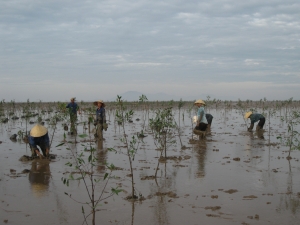Mangrove restoration in Viet Nam: national plans vs. local realities
Location: Hanoi, Vietnam. 9th Apr 2012
Vietnam’s government likes to deliver development through top-down national plans such as Program 661, the five million hectare reforestation program (that ended in 2010 and ended up replanting 2.5 million hectares over 12 years). The government’s fondness for national programs stems from a history of central planning, which involved central government issuing a huge number of targets for ministries to fulfill. The doi moi reforms of the mid-1980s officially moved Viet Nam to a market economy but the central planning mentality lingers.
Much can be said for national plans and standards in, for example, the area of infrastructure development, which requires coordinated logistics and investment across the entire country. After all, a cubic meter of concrete has the some properties and costs the same in the north as in the south. But the workshop on March 16, 2012 organized by GIZ and MARD that I attended on restoring mangrove forests in Viet Nam brought into focus the limits of national plans in the area of natural resources management.
Three basic problems emerged. The first is that after a decade of decisions, mater plans, guidelines, circulars, and regulations, mangroves are still being lost. A high resolution satellite-based study that IUCN and the Space Technology Institute completed in Ngoc Hien District, Ca Mau Province (which includes Mui Ca Mau National Park) showed a 30% decline in mangrove cover between 2004 and 2009. A study in Kien Giang Province by GIZ and the University of Queensland showed the same trend. Clearly, the current approach is not leading to the recovery of mangrove forests in these two provinces.
The second problem is that Viet Nam has a long, diverse, and dynamic coastline and the cost of restoring mangroves varies greatly from place to place. A study presented at the workshop showed that cost norms for planting mangroves ranged from $700/hectare (in muddy, easy to work soils) to over $4,000/hectare (in sandy, hard to work soils or where coastal erosion requires the construction of wave-breaks before mangroves can be planted). Under the 661 Program, the cost norms for planting and post-planting protection were $500/hectare and $5/hectare/year respectively, well below the real costs. In Can Gio, by contrast, households receive $35/hectare/year to protect mangroves.
Site specific and appropriate solutions are needed. However, when it was suggested to MARD that it was impractical to prepare guidelines for such a wide range of conditions, the answer was: “We need to provide more detailed guidelines.” This is reminiscent of the government’s response to the collapse in rice production in the pre-doi moi period, which was to issue more targets and send in more inspectors.
The third problem was stated by a government official from Thanh Hoa who said that it doesn’t matter how many master plans and guidelines are issued because they don’t address the conflicts of interest that encourage provincial governments to prioritize shrimp farming (or some other commercial use) over mangrove conservation. In other words, the incentives driving land use decisions at the local level conflict with MARD policy and until these interests are aligned (which is a political not a technical challenge), more paperwork won’t help.
A great deal is now known about how best to restore mangroves in Viet Nam. GIZ has produced handbooks that provide detailed guidance in the provinces where they work. It is therefore possible to envision a different strategy that would, first, raise awareness and reach agreement on broad objectives in terms of restoring a diverse and resilient mangrove forest at all levels; second, encourage experimentation and risk taking at the local level in terms of nursery design, species selection, community participation, and benefit sharing; third, monitor mangrove recovery to ensure transparency, accountability, and learning; and fourth, enforce the law against illegal mangrove clearing and conversion.

Women planting mangroves in Hau Loc, Thanh Hoa, Vietnam © MERD, 2012